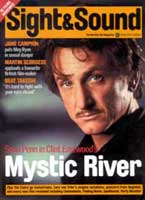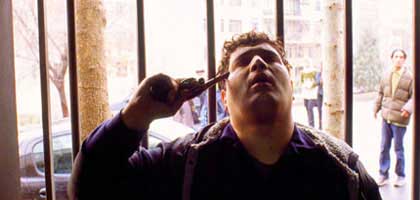
Crimson Gold
Iran 2003

Reviewed by Julian Graffy
Synopsis
Our synopses give away the plot in full, including surprise twists.
A Tehran jeweller (Shahram Vazira) is attacked while opening his shop. When he hits the alarm, his assailant, Hussein (Hossein Emadeddin), shoots him dead. As a crowd gathers, Hussein shoots himself.
Ali (Kamyar Sheisi), Hussein's sidekick, rides off on his motorbike into the long flashback that makes up the film. Hussein and Ali talk in a tea room about their plan for Hussein to marry Ali's sister (Azita Rayeji) and about the receipt for an expensive necklace which Ali has found in a bag he has snatched. They find the jewellers that sold it but are not allowed in.
By night they work as pizza-delivery boys. Hussein takes pizzas to a man who turns out to have been his senior officer at the Front. Another delivery is thwarted by a police raid on a party in an adjacent flat.
They return to the jewellers, this time with Hussein's fiance, but again they are humiliated and directed to a cheaper shop, which upsets Hussein.
A midnight delivery takes him to the opulent penthouse of a man called Pourang (Pourang Nakhaei) who, deserted by his girlfriend, invites him in. Hussein wanders round the flat in amazement. Next morning, as the jeweller unlocks his shop, Hussein knocks him to the ground...
Review
Like the heroes of Abbas Kiarostami's Close-Up (1989) and A Taste of Cherry (1997), or the little-girl protagonist of Panahi's own The White Balloon (1995), the taciturn pizza-deliverer Hussein spends the whole of Crimson Gold pursuing an obsessive goal, a goal that is both practical in this case buying a necklace for his fianc e and, more importantly, symbolic: achieving respect, becoming visible. As he criss-crosses bustling Tehran in pursuit of his aim, his episodic encounters provide a kaleidoscopic vision of the city, a structure deployed in both Panahi's The Circle (2000) and Kiarostami's 10 (2002). Here the two film-makers, Kiarostami as scriptwriter and Panahi as director, collaborate to produce another compassionate and revealing narrative of the tensions and ambiguities of life in contemporary Iran.
Hussein is a large, introspective man of few words. As we plunge, unannounced, into the flashback of his life, we learn about him mainly through the reactions of others: his fellow pizza men all admire him and his former officer describes him as a saint. He has fought in defence of his country perhaps it was there he underwent the experience that requires him now to take the cortisone that has blown up his face to give him a constant look of bewilderment. What this ordinary, overlooked man wants, doggedly and single-mindedly, is to be paid some attention. This is why he is drawn back to the jewellery shop where he was treated with such casual disdain. When he returns there with his fiance he is smartly dressed in a constraining grey suit, but still the jeweller ignores him.
Hussein is an unlikely hero, and a fragile backbone for the narrative, but his stillness attracts the compassion and the demonstrativeness of others. Ali, his younger friend, is much more bouncy, darting around him full of questions. Ali is constantly eyeing up women and asks Hussein what it was like when they used to walk the streets "naked", that is without their veils. Hussein did not find it offensive. Ali's unnamed sister, who is also Hussein's fianc e, is similarly a victim, kind and gentle with her unlikely partner, but herself terrified of inadvertently breaking the codes that govern the behaviour of Iranian women. Other fleetingly glimpsed characters such as fellow delivery boy Skinny, whose flashy oversized sneakers lead to his sudden death in a crash add to the picture of quiet desperation. These are characters who are oppressed by the intrusive society they live in, but all are searching for a way to autonomy.
At the other end of the social scale are the army officer, whose promise of help never materialises, and the jeweller and his assistant, whose exquisite politeness cannot conceal their indifference. This is also the world examined in the film's two longest episodes: an illicit party and a visit to the playboy, Pourang. The scene outside the party is doubly unnerving both because Panahi never spells out for the benefit of western viewers exactly what is happening (it seems to be the morality police, clamping down on illicit dancing) and because of the passivity with which people allow themselves to be arrested. This is a society in which not only the underclass is cowed.
The final episode, in which Hussein wanders around the penthouse of the absurdly wealthy Pourang, while Pourang, whom nostalgia has dragged back from the US, rails at this "city of lunatics", is structurally placed as the straw that must break Hussein's back. But it is crudely drawn and, like the party episode, overlong. Overall, the film lacks the tightness and tragic dynamism of The Circle, where the progression from one woman's story to another's plunged the viewer ever deeper into a maelstrom of appalled sympathy.
What the two films share is a brilliant use of a system of visual and aural metaphors. The pizza itself is employed as an emblem of a society in confusion. Why should a country with its own rich culinary culture fall prey to this imported form? But Crimson Gold's most pervasive image, one also deployed in The Circle, is that of imprisonment. The film opens to the frantic sound of a caged bird, a sound that recurs as Hussein lies in his cell-like flat and listens to a neighbour being arbitrarily taken away. At the start of the film we look out from the metal bars protecting the jeweller's shop, and at the end we return to them. In between, with sympathy, attentiveness, and, for the most part, with understatement, the lives of many of the denizens of this modern metropolis are revealed as being lived in a cage.
Credits
- Director
- Jafar Panahi
- Producer
- Jafar Panahi
- Screenplay
- Abbas Kiarostami
- Director of Photography
- Hossain Jafarian
- Editor
- Jafar Panahi
- Art Director
- Iraj Raminfar
- Music
- Peyman Yazdanian
